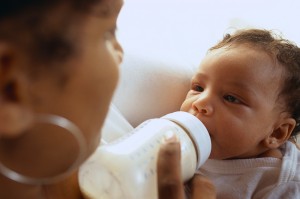>> Doing whatever we can to keep our children safe and healthy is an essential part of motherhood. But the prevalence of chemicals in everything from their food to their toys to their pajamas presents a tremendous challenge. A mom could miss her baby’s entire childhood trying to read all the research and theories on the Internet about chemicals and their possible effects on children’s development and health.
Doing whatever we can to keep our children safe and healthy is an essential part of motherhood. But the prevalence of chemicals in everything from their food to their toys to their pajamas presents a tremendous challenge. A mom could miss her baby’s entire childhood trying to read all the research and theories on the Internet about chemicals and their possible effects on children’s development and health.
According to the organization >>Toxic Free NC , there are more than 80,000 chemicals in the marketplace, and only a tiny fraction of them have ever been tested for health and safety. But there are certain chemicals that are common in products many children come in contact with daily that have been shown to have detrimental effects.
Toxic Free NC lists >>the following chemicals as potential hazards :
1. Bisphenol A (BPA) is a hormonedisrupting chemical found in polycarbonate plastic. BPA is widely used in food packaging, including baby food and formula.
2. Phthalates (BBP, DBP, DEHP) are used as softeners in PVC plastic such as children’s toys and fragrancebinders in personal care products like baby shampoo. Phthalates are hormonedisrupters, and exposure is linked to reproductive and respiratory problems and risk factors for breast cancer.
3. TRIS flame retardants are used in textiles such as nursery furniture and foam products like nursing pillows and the padding in carseats. They are linked to cancer, as well as adverse effects on learning and development. TRIS flame retardants were banned from children’s pajamas in the 1970s due to cancer risks but are back in the marketplace to replace hazardous Brominated flame retardants, which were taken off the market recently.
A baby who is sensitive to one of these chemicals can lose her chance at a healthy life before she’s even old enough to know what her own fingers are for. And even the most well-meaning parent can’t protect her child unless products with these chemicals are clearly labeled and affordable alternatives are widely available.
Learn more about children and chemical exposure at >>Toxic Free NC’s website.
“In 1992, Danish scientists published a meta-analysis of 61 studies on semen quality from around the world, concluding that the average sperm concentration had declined by nearly 50 percent over a 50-year period, from 113 million to 66 million sperm per milliliter…..In 2000, American researchers not only confirmed results from the original Danish semen quality study, they found sperm density in the United States and Europe to be falling at an even faster clip: by 1.5 to 3 percent per year. And last summer, an Israeli study noted a steady decline in semen quality at one local bank over the past 15 years. A full 38 percent of all sperm-donation applicants are now rejected, up from one-third prior to 2004. That year, the bank lowered its minimum sperm count for acceptance to widen its net for donors. Under those more stringent standards, 88 percent of contemporary samples would have been rejected.”